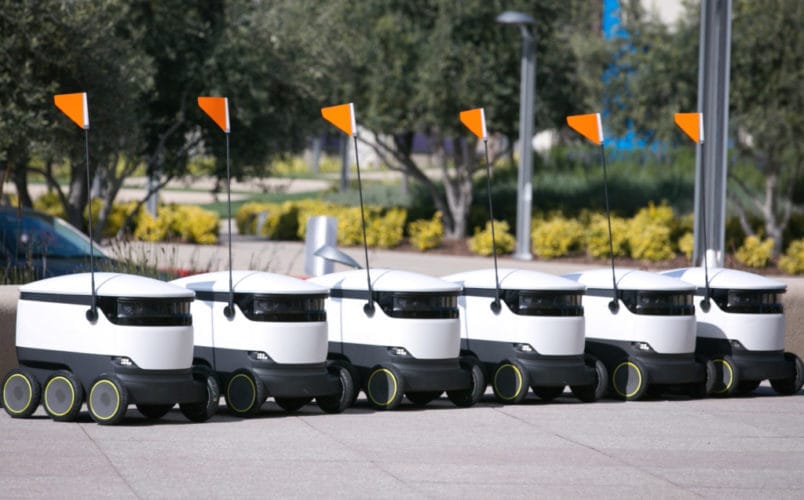- lunch with AI (Health with AI tec)
- Posts
- SHE is not real
SHE is not real
AI Putting Patients 1st?

What are our lunch choices today? Pick your favored bitesize AI and Robotics information for the day.
Heath, vital diagnostic tools, and AI makes health records vulnerable.
Wealth. Delivery robots.
Relationship, be carful of Deep fakes
Productivity/learning create your dream room
Government/laws: Meta and Open AI fighting Deep Fake
Dow | 38,654.83−71.50 (0.18%)today Feb 9, 1:15 PM EST |
S&P500 | 5,017.49+19.58 (0.39%)today Feb 9, 1:17 PM EST |
Tesla inc. (TLSA) | 192.96 USD+3.40 (1.79%)today Feb 9, 1:19 PM EST |
Microsoft (MSFT) | 419.62 USD+5.51 (1.33%)today Feb 9, 1:20 PM EST |
NVIDIA Corp | 716.98 USD+20.57 (2.95%)today Feb 9, 1:21 PM EST |
APPETIZER: Wealth

Starship Technologies, (I love robots) a pioneer in autonomous delivery robots, has secured $90 million in new funding, bringing their total to $230 million. This fresh injection of capital fuels their global expansion plans, aiming to capitalize on the surging demand for home deliveries.
Starship's sidewalk robots have already completed over 6 million deliveries across 80 locations worldwide, demonstrating their potential for profitability. The funding will be used to expand operations and enter new markets, further solidifying their position as a leader in the autonomous delivery space.
According toCoinbase, STARSHIP is trading at $0.0249 with a 24-hour trading volume of $2.78K Disclaimer: – this is not a recommendation and is not a guarantee of price, as pricing can change rapidly. Read more
A Little Salad: health
Chest X-rays are vital diagnostic tools, interpreting them accurately, has in the past, requires expertise. Excitingly, AI is stepping in to assist non-radiologists like emergency room doctors, boosting their ability to read these images. This improves diagnostic accuracy and also speeds up decision-making, potentially leading to faster treatment and better patient outcomes. They say, AI won't replace radiologists, but it’s becoming a valuable ally in ensuring accurate chest X-ray interpretation, even in situations where specialists aren't immediately available. Read more
While AI HIPPA laws may not be enough, the increasing computing power makes everything more vulnerable to cyberattacks. read more
AI Revolution: Putting Patients at the Heart of Healthcare Innovation
The healthcare landscape is undergoing a paradigm shift, with artificial intelligence (AI) emerging as a powerful force for transformation. But amidst the buzz of algorithms and machine learning, one crucial element remains paramount: patient-centered care.
The good news is, AI innovations are increasingly designed to empower patients and personalize their healthcare experience. Here's how:
1. Precision Medicine: AI can analyze vast datasets of genetic, medical, and lifestyle information, paving the way for personalized diagnoses and treatment plans.
2. Proactive Care: AI algorithms can analyze trends in patient data to predict potential health risks before they manifest. This allows for early intervention and preventive measures, potentially saving lives and improving long-term health outcomes.
3. Empowered Patients: AI-powered chatbots and virtual assistants can provide 24/7 access to information and support for patients.
4. Shared Decision-Making: AI can present complex medical data in an easily understandable format, facilitating informed discussions between patients and healthcare providers.
5. Mental Health Support: AI-powered tools can provide personalized therapy and mental health support, particularly in areas with limited access to specialists. Chatbots can offer cognitive behavioral therapy techniques, while AI-powered analysis can identify individuals at risk of mental health issues.
Ethical considerations remain crucial, with data privacy as a major concern. Transparency, responsible development, and human oversight are essential (at least for now).
The future of healthcare is undoubtedly intertwined with AI. If it is posable to prioritizing patient needs and address ethical challenges, the power of this technology might help create truly personalized, proactive, and Health care.
Read more at “BMC medical informaitics”.
Main Course: .
Fighting Fakes

Woman on the sidewalk
Be careful; don’t assume what you see is real. She is AI-generated.
The war against deepfakes just got a new weapon. Tech giants Meta (formerly Facebook) and OpenAI have joined forces to tackle the growing problem of manipulated images by labeling AI-generated content. Soon, users on platforms like Facebook and Instagram will see "Imagined with AI" tags accompanying photorealistic images created by artificial intelligence tools.
This move aims to combat the rising tide of deepfakes, where AI is used to convincingly superimpose faces or objects onto images or videos. While often harmless, deepfakes can be weaponized to spread misinformation, damage reputations, and sow discord. By labeling AI-generated content, Meta and OpenAI hope to increase transparency and empower users to critically evaluate the information they encounter online. We will see how that works and how possible it will be to remove these tags, but it is a start.
This initiative goes beyond mere labeling. Both companies are actively developing detection tools to automatically identify AI-manipulated content, even if it lacks visible markers. OpenAI's "Stable Signature" technology embeds an invisible watermark during image creation, while Meta is working on classifiers to analyze features and identify generated content.
While labelling and detection offer valuable tools, the fight against deepfakes remains complex. Continued collaboration between tech companies, policymakers, and the public is crucial to navigate the ethical and technological challenges posed by AI-generated imagery. This initial step by Meta and OpenAI marks a positive step towards a more informed and authentic online experience. read more
Google is upping its AI game.
Google's AI assistant Bard has undergone a metamorphosis, emerging as the new and improved "Gemini." This evolution brings two key advancements:
1. Enhanced Capabilities: Gemini boasts the advanced "Pro 1.0" model, offering greater power and versatility in tasks like writing, translating, and generating creative content.
2. Expanded Reach: Gemini transcends its predecessor's limitations, becoming accessible in over 40 languages and 230+ countries, making it a truly global AI companion.
Additionally, Gemini introduces "Gemini Advanced" - a premium subscription tier offering even more powerful features and services. This caters to users who demand the most advanced AI assistance available.
Overall, the Bard to Gemini transformation signifies Google's commitment to pushing the boundaries of AI and making it more accessible and helpful for users worldwide. Read more
Productivity:
Design any room using AI technology. Dreamy rooms
Can AI help you feel better? YUNA believes it can
Dessert: Robotics
This is incredible.
"China has Released its Most Advanced Robots that Can Do Anything" showcases several new robotic technologies. A new line of robots from a Chinese manufacturer includes a humanoid robot with advanced motion control capabilities, a robo-dog that responds to voice commands and human movements, and the XR4, which aims to be a human companion with over 60 joints and intelligent training. Other robots include the Titanoboa, a massive snake-shaped robot designed for demonstrating energy solutions, and the Kobot 4, a mobile manipulator robot offering functionality and emotions in a sleek design. The video also highlights technological advancements, such as the LED Box from a Polish company that displays advertisement videos, Google's stair-cleaning robots, Hyundai's innovative wheel rotation system, and a British robot designed for inspecting and repairing offshore wind turbines with six limbs and advanced capabilities. These robots and technologies represent the latest steps towards perfect machines and alternative solutions to everyday challenges.
"Why The Tesla Bot Will Take Over In 2024!", Elon Musk's vision of a humanoid robot named Tesla Bot is discussed. The robot, which is expected to replace humans in performing unsafe, repetitive, or dull tasks, has undergone significant development with prototypes like Bumblebee and Optimus. The latest Optimus Gen 2bot showcases 11 joints in its arms, improved body control, tactile sensing, and human-like interaction, making it a game-changer in the manufacturing industry. Musk's Bot, which utilizes an AI-powered neural network and a vision-based system, differs from the time-consuming and limiting approach of earlier humanoid robots. The rapid development of Tesla's Optimus bot raises concerns about a future where robots outnumber humans, posing questions about job displacement and societal changes. Despite these apprehensions, Musk has assured that the bots will not be a threat to humans, and Tesla plans to manufacture these robots on a large scale by 2024.
Disclaimer: None of the information here is financial advice. This newsletter is for informational purposes only and not to be used as investment advice or a solicitation to buy or sell any assets. Any and all financial decisions you make should be carefully researched on your own or discussed with a financial advisor.
Reply